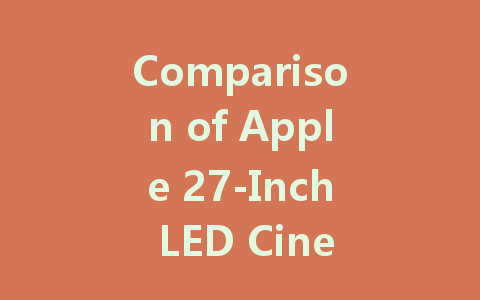
When it comes to high-quality displays for professional or recreational use, Apple has set a high bar with its series of cinema displays. Among these, the Apple 27-inch LED Cinema Display and the Thunderbolt Display are notable for their performance and aesthetic appeal. In this article, we’ll dive into the characteristics, specifications, and practical uses of each display to help you determine which is the perfect fit for your needs.
Overview of the Apple 27-Inch LED Cinema Display
The Apple 27-inch LED Cinema Display, launched in 2010, is known for its stunning visuals and sleek design. With an impressive resolution of 2560 x 1440 pixels, it delivers vibrant colors and sharp details, making it a preferred choice for graphic designers and photographers. The display features an LED backlight that enhances brightness and energy efficiency.
Key Features
Overview of the Thunderbolt Display
Launched in 2011, the Thunderbolt Display takes everything great about the LED Cinema Display and enhances it with advanced technology. It maintains the same resolution as its predecessor but offers faster connectivity options and better performance overall.
Key Features
Performance Comparison
When comparing performance between the two displays, several factors come into play, including color accuracy, brightness, and overall user experience.
Display Quality
Both displays offer excellent color accuracy and brightness levels. However, the Thunderbolt Display scales slightly better, providing more vibrant color representation due to its advanced technology. For professionals who rely on impeccable color matching, this could be a crucial distinction.
Speed and Responsiveness
Thanks to the Thunderbolt connectivity, the Thunderbolt Display excels in responsiveness and speed. When connected to compatible Apple devices, it delivers lower latency and faster data transfer rates, making it ideal for tasks that require seamless integration between devices.
Compatibility and Usage
Device Compatibility
The Apple 27-Inch LED Cinema Display is compatible with a range of Apple devices but is limited to Mini DisplayPort connections. Conversely, the Thunderbolt Display’s Thunderbolt port allows it to connect with newer devices and even daisy chain multiple displays. If you’re using a recent MacBook or iMac, the Thunderbolt Display could be the better choice for future-proofing your setup.
Use Cases
Both displays cater well to creative professionals such as video editors, graphic designers, and photographers. If you prioritize speed and connectivity in your workflow, the Thunderbolt Display is likely the better option. However, if you find yourself working primarily on older devices or don’t require daisy chaining, the older 27-inch LED Cinema Display still offers a great experience.
Pricing and Availability
As of now, both displays are considered vintage tech and may not be easily available new. Prices will vary depending on the condition (new or refurbished) and rarity in the used market. Generally, the Thunderbolt Display tends to be priced slightly higher due to its advanced features and enhanced performance.
Conclusion
Choosing between the Apple 27-inch LED Cinema Display and the Thunderbolt Display depends largely on your specific needs and devices. If speed, connectivity, and enhanced performance are your top priorities, the Thunderbolt Display may be the optimal choice. On the other hand, if you’re looking for a more affordable option that still offers impressive display quality, the older LED Cinema Display will serve you well.
Regardless of your choice, both displays represent Apple’s commitment to delivering high-quality visual experiences that can elevate any workspace. Take the time to assess your requirements and select the one that best complements your setup.